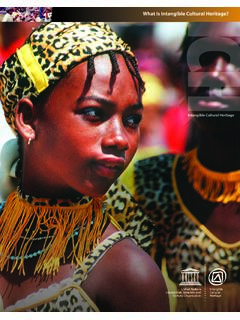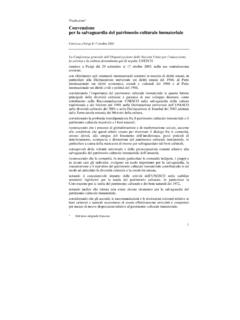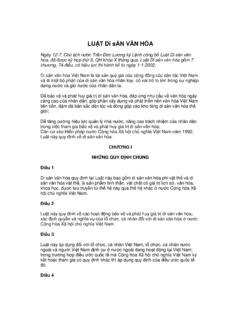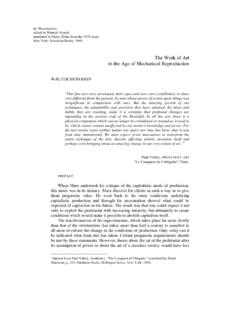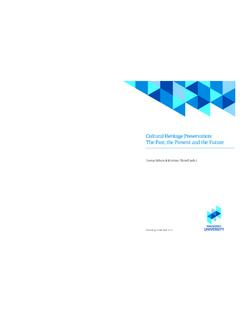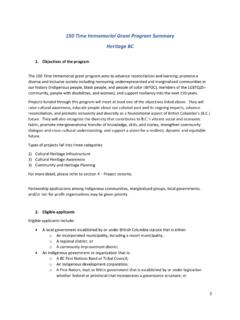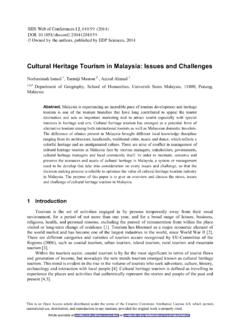Transcription of 2003 Convention for the Safeguarding of the Intangible ...
1 Sixth session of the Intergovernmental Committee for the Safeguarding of the Intangible cultural heritage 22-29 November 2011, Bali, IndonesiaMEDIA KIT2003 Convention for the Safeguarding of the Intangible cultural HeritageUnited NationsCultural OrganizationIntangibleCulturalHeritageYo u will find in this kit ..1. Sixth Session of the Intergovernmental Committee for the Safeguarding of the Intangible cultural heritage , basic information2. Elements inscribed in 20113. Questions and answers4. Intangible heritage in different countries5. Inscription process6. Facts and figures mEdia kitUnited NationsCultural OrganizationIntangibleCulturalHeritagePa ge 11. Sixth Session of the intergovernmental Committee for the Safeguarding of the Intangible cultural heritage ( )22 to 29 November 2011, Bali, indonesiaBali International Convention Centre (BICC)Address: Kawasan BTDC, Lot N3, Nusa Dua, Bali 80363, IndonesiaTel: +62 361 771 906/ Fax: +62 361 771 908 Committee s main functions are to promote the objectives of the Convention for theSafeguarding of the Intangible cultural heritage objectives, provide guidance on best practices and make recommendations on measures for Safeguarding Intangible cultural heritage .
2 The Committee examines States reports on the implementation of the Convention , nominations submitted by countries for inscription on the ICH Lists and proposals for programmes and projects that best reflect the objectives of the Convention ; it is also in charge of granting international assistance. The Committee s 24 members are elected by the General Assembly of the States Parties according to rules of equitable geographical representation and : Aman Wirakartakusumah (Indonesia)Vice-Chairs: Albania, Nicaragua, Niger, Morocco and Spain Rapporteur: Ion de la Riva (Spain)Committee 24 members:Albania, Azerbaijan, Burkina Faso, China, Croatia, Cuba, Cyprus, Czech Republic, Grenada, Indonesia, Iran (Islamic Republic of ), Italy, Japan, Jordan, Kenya, Madagascar, Morocco, Nicaragua, Niger, Oman, Paraguay, Republic of Korea, Spain and Venezuela (Bolivarian Republic of ) For online media kit, live webcast of the Committee meeting and more please go to: Secretariat of the Convention :Ms C cile Duvelle, Secretary of the ConventionE-mail.
3 Edmond Moukala, Responsible for mediaE-mail. inquiries:Mr Rasul Samadov E-mail. Ms Isabelle Le FournisE-mail: kitUnited NationsCultural OrganizationIntangibleCulturalHeritagePa ge 2mEdia kit2. Elements inscribed during the 6th session of the CommitteeURGENt Safeguarding LiStOf the 23 candidates for the Urgent Safeguarding List, 11 were , the Enawene Nawe people s ritual for the maintenance of social and cosmic Yimakan li, Iranian dramatic story-tellingIran skills of building and sailing Iranian Lenj boats in the Persian GulfIran society of the K r dugaw, the rite of wisdom in Moorish epic T long song performance technique of Limbe performances - circular , Har kmbut sung prayers of Peru s Huachipaire Sadu, traditional weaving skills in the United Arab EmiratesUnited Arab singing of Ph Th Province, Viet NamViet NamREGiStER OF BESt Safeguarding PRaCtiCESOut of 12 proposals for Best Safeguarding Practices, 5 were programme of cultivating ludodiversity.
4 Safeguarding traditional games in for projects of the National Program of Intangible s Living T nch z method: a Hungarian model for the transmission of Intangible cultural of the traditional craftsmanship of lime-making in Mor n de la Frontera, Seville, AndalusiaSpainUnited NationsCultural OrganizationIntangibleCulturalHeritagePa ge 3mEdia kitREPRESEN tatiVE LiStOut of 49 nominations for the Representative List, 19 were age set ritual shadow knowledge of the jaguar shamans of Yurupar arac singing and playing from Eastern Kolo, silent circle dance of the Dalmatian poetic of the Kings in the south-east of the Czech RepublicCzech in the French no Hana Taue, ritual of transplanting rice in Mibu, Shin Noh, sacred dancing at Sada shrine, practices and expressions linked to the balafon of the Senufo communities of Mali and Burkina FasoMali, Burkina , string music, song and to the sanctuary of the Lord of Qoyllurit.
5 Urban popular song of , tightrope walkingRep , a traditional Korean martial artRep of Mosi (fine ramie) in the Hansan regionRep of la Mare de D u de la Salut of Algemes Ke kek traditionTurkeyUnited NationsCultural OrganizationIntangibleCulturalHeritagePa ge 43. Questions and answersWhat is Intangible cultural heritage ? Intangible cultural heritage ( ICH ) refers to the practices, representations, expressions, knowledge and know-how, transmitted from generation to generation within communities, created and transformed continuously by them, depending on the environment and their interaction with nature and , as it is transmitted from generation to , as it provides to communities a sense of identity and continuity, as culture does. Intangible , as it lies essentially in the human spirit, is transmitted by imitation and immersion in a practice, and doesn t necessarily require a specific place or material objects.
6 Intangible cultural heritage exists only in the present. The expressions of the past that are no longer practised are part of cultural history, but are not Intangible cultural heritage as defined in the Convention for the Safeguarding of Intangible cultural cultural heritage is what communities today recognize as part of their cultural heritage . Therefore, it is often called living heritage .Why is it important? Intangible cultural heritage adapts permanently to the present and constitutes cultural capital that can be a powerful driver for development. Food security, health, education, sustainable use of natural resources Intangible cultural heritage is a wealth of knowledge to be used in many aspects of life. Women hold a special place in the transmission of Intangible heritage and have knowledge that contributes to their empowerment and to revenue generation.
7 ICH is also vital for maintaining cultural diversity in the face of globalization. Understanding ICH contributes to intercultural dialogue, encourages mutual respect and ensures social importance of ICH is not the cultural manifestation itself; it lies in its significance to communities. Its value is both Intangible and tangible, linked to the social and economic effects of the knowledge and skills transmitted through out more and see examples in the brochure included in this kit and at Why is this UNESCO s concern?As the only United Nations agency with a specific mandate in culture, UNESCO works to safeguard cultural heritage and promote cultural diversity as a force for dialogue and development. It encourages international cooperation and knowledge-sharing and supports Member States in building their human and institutional is UNESCO s Convention for the Safeguarding of the Intangible cultural heritage ?
8 Adopted in 2003 after 60 years of work in this domain, the Convention is the international community s first binding multilateral instrument intended to safeguard and raise the profile of this heritage . Its goal is to incite countries to care about and look after the ICH present on their are the responsibilities of States that ratify the Convention ?At the national level, States Parties are asked to take the necessary measures to safeguard the ICH present on their territory: define and inventory the ICH, with the participation of the communities concerned; adopt policies and establish institutions to monitor and promote it; encourage research; and take other appropriate Safeguarding measures, always with the full consent and participation of the communities concerned. Each State Party submits regular progress reports to the Committee, starting six years after ratifying the Convention .
9 The first ever submitted reports are coming this year (see the Agenda of the Committee).mEdia kitUnited NationsCultural OrganizationIntangibleCulturalHeritagePa ge 5 States are also invited to nominate elements to the List of Intangible cultural heritage In Need of Urgent Safeguarding , the Representative List of the Intangible cultural heritage of Humanity, and the Register of Best Safeguarding Practices, which are all mechanisms to focus international attention on ICH. States also have the possibility of asking for international assistance from the Fund for the Safeguarding of the Intangible cultural heritage . The resources of this Fund consist of contributions made by States Parties. Only the States Parties to the Convention may submit nominations. They have an obligation to ensure the widest possible participation of the communities in elaborating the Safeguarding measures.
10 They must also obtain their free, prior and informed consent. Nominations or requests for international assistance made by several States are strongly encouraged, as many elements of Intangible cultural heritage are present in several territories and practised by a community established in several countries, contiguous or the text of the Convention : What are the criteria for the Lists? To be inscribed on either of the Lists, an element must satisfy five inscription criteria. Three of these are common to both the Urgent Safeguarding List and the Representative List. First, the element proposed must fit the definition of ICH in Article 2 of the Convention . The element must also be included in an inventory, and nominated with the consent and widest possible participation of the communities concerned. Safeguarding measures must be elaborated, and the State must demonstrate, for the Urgent Safeguarding List, that despite the efforts of the State and community concerned, the viability of the element is at risk.
